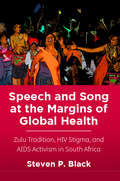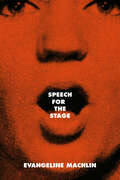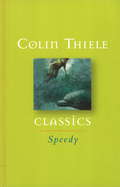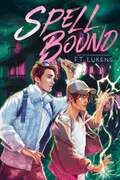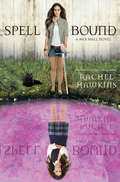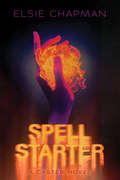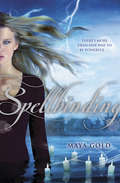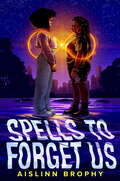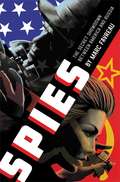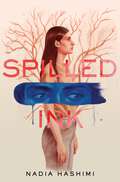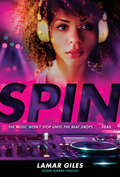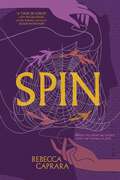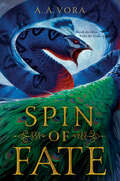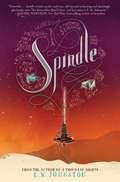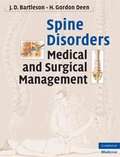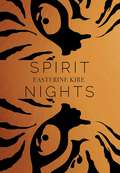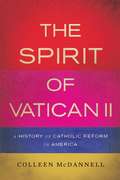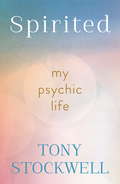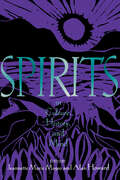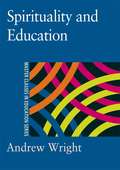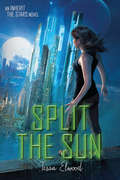- Table View
- List View
Speech and Song at the Margins of Global Health: Zulu Tradition, HIV Stigma, and AIDS Activism in South Africa
by Steven P. BlackSpeech and Song at the Margins of Global Health tells the story of a unique Zulu gospel choir comprised of people living with HIV in South Africa, and how they maintained healthy, productive lives amid globalized inequality, international aid, and the stigma that often comes with having HIV. By singing, joking, and narrating about HIV in Zulu, the performers in the choir were able to engage with international audiences, connect with global health professionals, and also maintain traditional familial respect through the prism of performance. The focus on gospel singing in the narrative provides a holistic viewpoint on life with HIV in the later years of the pandemic, and the author’s musical engagement led to fieldwork in participants’ homes and communities, including the larger stigmatized community of infected individuals. This viewpoint suggests overlooked ways that aid recipients contribute to global health in support, counseling, and activism, as the performers set up instruments, waited around in hotel lobbies, and struck up conversations with passersby and audience members. The story of the choir reveals the complexity and inequities of global health interventions, but also the positive impact of those interventions in the crafting of community.
Speech for the Stage
by Evangeline MachlinFrom its original publication, thousands of actors have used this classic text to develop and refine their voice and speech. Evangeline Machlin includes warm-up routines for the voice but initially focuses on the importance of listening. She also discusses such important elements as relaxation, phonetics, articulation, resonance, pitch, rate of speech and stress. In addition, there are chapters on dialects, on reading aloud, sight reading, auditioning and performance.
Speedy
by Robert Ingpen Colin ThieleA heartwarming adventure from Australia?s master storyteller.Speedy is the fastest, cleverest dolphin ever to swim the waters around Kangaroo Island. To ten-year-old Mike and his fisherman father Ben, he is also a very special friend, always there to meet their boat and lead her home into the harbour. Speedy soon becomes a tourist attraction in their small fishing town. But not everyone loves him as much as Ben and his friend Sally, and one day they realise that the friendly dolphin is in deadly danger.
Spell Bound
by F.T. LukensAn instant New York Times bestseller! Two rival apprentice sorcerers must team up to save their teachers and protect their own magic in this &“charming and engaging&” (School Library Journal) young adult romantic adventure from the author of In Deeper Waters and So This Is Ever After.Edison Rooker isn&’t sure what to expect when he enters the office of Antonia Hex, the powerful sorceress who runs a call center for magical emergencies. He doesn&’t have much experience with hexes or curses. Heck, he doesn&’t even have magic. But he does have a plan—to regain the access to the magical world he lost when his grandmother passed. Antonia is…intimidating, but she gives him a job and a new name—Rook—both of which he&’s happy to accept. Now all Rook has to do is keep his Spell Binder, an illegal magical detection device, hidden from the Magical Consortium. And contend with Sun, the grumpy and annoyingly cute apprentice to Antonia&’s rival colleague, Fable. But dealing with competition isn&’t so bad; as Sun seems to pop up more and more, Rook minds less and less. But when the Consortium gets wind of Rook&’s Spell Binder, they come for Antonia. All alone, Rook runs to the only other magical person he knows: Sun. Except Fable has also been attacked, and now Rook and Sun have no choice but to work together to get their mentors back…or face losing their magic forever.
Spell Bound (A Hex Hall Novel #3)
by Rachel HawkinsHailed as "impossible to put down," the Hex Hall series has both critics and teens cheering. With a winning combination of romance, action, magic and humor, this third volume will leave readers enchanted. Just as Sophie Mercer has come to accept her extraordinary magical powers as a demon, the Prodigium Council strips them away. Now Sophie is defenseless, alone, and at the mercy of her sworn enemies-the Brannicks, a family of warrior women who hunt down the Prodigium. Or at least that's what Sophie thinks, until she makes a surprising discovery. The Brannicks know an epic war is coming, and they believe Sophie is the only one powerful enough to stop the world from ending. But without her magic, Sophie isn't as confident. Sophie's bound for one hell of a ride-can she get her powers back before it's too late?
Spell Starter (A Caster Novel)
by Elsie ChapmanThe Sting meets Fight Club in this magical, action-packed sequel to Caster by Elsie Chapman.Every spell cast needs a starter.Aza Wu now has magic back. But like all things in her life, it has come at a great cost. After winning the Tournament of Casters, Aza is able to pay off her parents' debt to Saint Willow. But the price of the gathered spell she used to strip Finch of his magic has put her permanently in the employ of the gang leader. And the magic that has been returned to her is not her own.Aza is forced to use this magic, stolen and unpredictable, to do Saint Willow's dirty work. But the gang leader is ambitious and power-obsessed, and she always seems to have a larger plan. Aza knows that if Saint Willow can benefit, it doesn't matter who gets hurt along the way.Forced into a dangerous new situation, Aza will have to reckon with the choices she's made and the unstable magic she wields. If she can find a way out of Saint Willow's hold, she just might survive. That is, if her casting doesn't finally consume her.
Spellbinding
by Maya GoldThere's more than one way to be powerful . . .Abby Silva has made a startling discovery: She is descended from accused witches who lived in 1600s Salem. When Abby visits Salem, strange and inexplicable events unfold. Objects move on their own. Candles burst into flame. An ancient spell book winds up in her possession.Soon, Abby is thrust into a world of hexes, secrets, and danger. And then there's Rem Anders, the beautiful, mysterious Salem boy who knows more about Abby than he first lets on.A reckoning is coming, and Abby will have to make sense of her history--and her heart--before she can face the powerful truth.
Spells to Forget Us
by Aislinn BrophyA witch and a non-magical girl get stuck in an endless cycle of meet-cutes and breakups in this heart-stopping romantic young adult fantasy."A seamless, mind-bending exploration of love and identity that manages to completely re-invent the time-loop story....You&’ll never read a book quite like this again." —Mark Oshiro, #1 New York Times bestselling author of Into the LightLuna is a powerful witch. Known for her skills and feared for her temper, she&’s set to preserve her family&’s legacy by becoming the head of Boston&’s Witch Council—a job she does not want.Aoife is a non-magical girl. Raised under the lens of her influencer family, she&’s grown up in the public eye. Now she yearns for privacy—but knows her parents won&’t oblige.Just when they are at their lowest, Aoife and Luna find each other and start dating. As decreed by magic law, Luna casts a spell that will erase Aoife&’s memories of their history together if they ever break up. But when Aoife and Luna end things, it&’s both of them who forget . . . that is, until they meet again, fall for each other, and recover all the memories of their last attempt at dating.So begins the story of two star-crossed lovers who keep finding their way into each other&’s orbits, even as the universe pulls them apart. When they set out to break the cycle, will they be strangers forever or together at last?"A whirlwind of whimsical romance and examinations of autonomy and familial duty." —Jas Hammonds, award-winning author of We Deserve Monuments
Spies: The Secret Showdown Between America and Russia
by Marc FavreauA thrilling account of the Cold War spies and spycraft that changed the course of history, perfect for readers of Bomb and The Boys Who Challenged Hitler.The Cold War spanned five decades as America and the USSR engaged in a battle of ideologies with global ramifications. Over the course of the war, with the threat of mutually assured nuclear destruction looming, billions of dollars and tens of thousands of lives were devoted to the art and practice of spying, ensuring that the world would never be the same.Rife with intrigue and filled with fascinating historical figures whose actions shine light on both the past and present, this timely work of narrative nonfiction explores the turbulence of the Cold War through the lens of the men and women who waged it behind closed doors, and helps explain the role secret and clandestine operations have played in America's history and its national security.
Spilled Ink
by Nadia HashimiIn this insightful and affecting YA novel by well-loved author of books for adults and middle graders Nadia Hashimi, an Afghan American teenager's small town is thrown into controversy and violence when her brother, taking a stand against hatred, plays a prank that some think went too far…When Yalda hears that her twin brother, Yusuf, will be performing with his band at a local venue, she lets her friends convince her to sneak out to see his show. But the night has something else in store: After the opening band makes some ugly jokes about “terrorists,” Yusuf uses his time in the spotlight for an impulsive stunt responding to the hate speech. Suddenly, simmering tensions begin boiling over in their Virginia town, where many Afghan refugees have sought safety. When a video of Yusuf’s performance goes viral online, it seems like everyone in town turns against their family’s restaurant, leaving their livelihood in jeopardy. And then Yusuf is seriously injured in a mysterious fall.Despite her grieving and frightened family, friends she is not sure she can trust, and a town that no longer feels like a safe home, Yalda must try to find her own voice—and do what she can to change her world for the better.
Spin
by Lamar GilesEven in murder, the music lives on.When rising star Paris Secord (aka DJ ParSec) is found dead on her turntables, it sends the local music scene reeling. No one is feeling that grief more than her shunned pre-fame best friend, Kya, and ParSec's chief groupie, Fuse -- two sworn enemies who happened to be the ones who discovered her body.The police have few leads, and when the trail quickly turns cold, the authorities don't seem to be pushing too hard to investigate further. But nobody counted on Paris's deeply loyal fans, ParSec Nation, or the outrage that would drive Fuse and Kya to work together. As ParSec Nation takes to social media and the streets in their crusade for justice, Fuse and Kya start digging into Paris's past, stumbling across a deadly secret. With new info comes new motives. New suspects. And a fandom that will stop at nothing in their obsessive quest for answers, not even murder...
Spin
by Rebecca CapraraA Chicago Public Library Teen-Approved Best Book of 2023 &“A powerful feminist retelling of an ancient tale about empathy and defiance, written in beautiful verse from a truly unique viewpoint.&” —Margarita Engle, Newbery Honor–winning author of The Surrender Tree and Young People&’s Poet Laureate The Song of Achilles and Circe get a sapphic, young adult twist in this &“exciting, richly textured, thought-provoking&” (Kirkus Reviews, starred review) retelling of the myth of Arachne spun in moving verse.Arachne is a homely girl with no claims to divinity or fortune, ostracized by all but her family and closest friend, Celandine. Turning to her loom for solace, Arachne learns to weave, finding her voice and her strength through the craft. After a devastating loss, Arachne and Celandine flee to the city of Colophon, where Arachne&’s skills are put to the test. Word of her talent spreads quickly, leading to a confrontation with the goddess Athena, who demands that Arachne repent for her insolence and pride. But Arachne will not be silenced. She challenges Athena, and a fateful weaving contest ensues, resulting in an exposé of divine misdeeds, a shocking transformation, and unexpected redemption. A brilliant weaver of words, author Rebecca Caprara transforms an ancient myth into a sweeping novel in verse, unraveling the tales that frame Arachne as a villainess and deliver a timely story of long-awaited justice.
Spin of Fate (The Fifth Realm #1)
by A. A. VoraIn a world inspired by karma, three teens encounter magnificent beasts, unforgiving magic, and epic battles in this propulsive and wholly original young adult fantasy.&“Evocative of Sanderson, Pullman, and Fullmetal Alchemist, yet at the same time shockingly original.&” —Rosaria Munda, author of FireborneAina&’s world is governed by Toranic Law, a force that segregates people into upper and lower realms. It&’s said that if the sinful lowers commit themselves to kindness and charity, their souls will lighten, allowing them into the peaceful upper realms.But Aina, one of the few lowers to ever ascend, just wants to go back home.Aina is desperate to reunite with her mother, hoping she&’s survived the beasts and wars of her homeland alone. After failing to weigh down her soul with petty crimes, Aina joins a rebel group defying the authorities and bringing aid to those condemned to a life of suffering in the lower realms. Alongside Aina are two new recruits: Meizan, a ruthless fighter trying to save his clan from extinction, and Aranel, a spoiled noble spying for the powers that be.Before long, the rebels find themselves in the middle of a brewing war. On one side, a violent king of a lower realm is bent on destroying Toranic Law; on the other, the authorities of the upper realms will do anything to stay on top. Now the young rebels must face both sides head-on if they want to stop a conflict that could break not only Toranic Law—but the universe itself.Fans of epic, propulsive fantasies like Six of Crows and innovative world-building like Avatar: The Last Airbender will delight in A. A. Vora's ambitious, unmissable debut.
Spinal Cord Injury: A Guide for Living
by Sara Palmer Kay Harris Kriegsman Jeffrey B. PalmerThe authors created this self-help guide for those who have suffered a spinal cord injury because "Our experience... tells us that recovery and successful living after injury go more smoothly when people know what to expect." The descriptions of each aspect of life following the injury, from what happens in the hospital and the emotional effects which accompany the trauma, to the new lives experienced afterward, are supplemented with the personal stories of those who have suffered this injury. Of the three authors, two are psychologists and one is an MD affiliated with the rehabilitation program at Johns Hopkins University School of Medicine. A list of resources is included. Annotation c. Book News, Inc., Portland, OR (booknews.com)
Spindle
by E. K. Johnston"The most powerful stories encompass a paradox. Spindle is both mythic and true, old beyond reckoning and dazzlingly, gloriously new. You've known this story all your life; you have never heard its like before. The Storyteller Queen lives, and her name is E. K. Johnston." -Rachel Hartman, New York Times best-selling author of Seraphina The world is made safe by a woman...but it is a very big world.It has been generations since the Storyteller Queen drove the demon out of her husband and saved her country from fire and blood. Her family has prospered beyond the borders of their village, and two new kingdoms have sprouted on either side of the mountains where the demons are kept prisoner by bright iron, and by the creatures the Storyteller Queen made to keep them contained.But the prison is crumbling. Through years of careful manipulation, a demon has regained her power. She has made one kingdom strong and brought the other to its knees, waiting for the perfect moment to strike. When a princess is born, the demon is ready with the final blow: a curse that will cost the princess her very soul, or force her to destroy her own people to save her life.The threads of magic are tightly spun, binding princess and exiled spinners into a desperate plot to break the curse before the demon can become a queen of men. But the web of power is dangerously tangled--and they may not see the true pattern until it is unspooled.
Spine Disorders: Medical and Surgical Management
by J. D. Bartleson H. Gordon DeenAn essential, one-stop reference guide to the evaluation and treatment of patients with cervical, thoracic and lumbar spine disease. Based on a course taught by these highly respected authors at the American Academy of Neurology's Annual Meeting, this volume gives concise descriptions of the anatomy of spine conditions; neurologic and physical findings; advice on diagnostic tests and when to order them; and medical and surgical treatment options. Commonly performed spinal procedures are also described, including the rapidly changing field of minimally invasive surgery. Pitfalls of evaluating and treating spine patients are highlighted, along with advice on how to approach the patient who does not improve or worsens after spine surgery. Spine Disorders: Medical and Surgical Management is an essential purchase for all practitioners in this field.
Spinoza-Arg Philosophers (Arguments Of The Philosophers Ser.)
by R.J. DelahuntyThis book is available either individually, or as part of the specially-priced Arguments of the Philosphers Collection.
Spirit Nights
by Easterine Kire&‘Tiger has eaten the sun!&’ screams Tola the seeress when darkness suddenly descends at midday, and the great spiritual struggle begins to restore the light.An ancient prophecy is fulfilled when darkness envelops a number of villages for days on end. The only thing they know is that a terrible taboo has been violated in the spirit world. Only by crossing the borders between the natural world and the spirit world, and acting with wisdom and courage can they get the light back, but who will dare to do that? Accounts of sudden darkness descending on the land exist in at least two tribal histories of the Naga people, the Rengma and the Chang. The story of Spirit Nights is inspired by a story of darkness narrated by the Chang Naga tribe. Names and incidents are borrowed from the original tale, but it follows the path of fiction to achieve its telling.
Spirit of Vatican II: A History of Catholic Reform in America
by Colleen McdannellThe author's mother, Margaret, was a 34-year-old mother of two young children in 1962, when the Second Vatican Council began a round of broad reforms which transformed the daily lives of practicing American Catholics. For Catholics of Margaret's generation, who lived through the Great Depression and the 9/11 terrorist attacks, Vatican II was a watershed event. Writing in an accessible style, McDannell (history, religious studies, University of Utah-Salt Lake City) uses the story of her mother's life as a unifying narrative thread to demonstrate the lasting legacies of Vatican II, showing how the reforms brought Margaret, and millions of other ordinary women like her, into more intimate contact with the ritual and theological life of the church. The author's popular writings on religion have appeared in the New York Times Magazine and BookForum. Annotation ©2011 Book News, Inc. , Portland, OR (booknews. com)
Spirited
by Tony StockwellEven as a child, Tony Stockwell knew that he was different and that he had been born to do something special with his life. His first out-of-body experience was when he was a baby and he met his first spirit person when he was seven. He has been working as a medium for 18 years and, in his hugely successful TV series Street Psychic, he used his astonishing gift to deliver accurate, deeply personal messages from loved ones in the world of spirit to randomly picked passers-by. Tony's autobiography answers ageless questions like:'What happens to us after we die?', 'What happens to animals and pets?', 'Are there such things as evil spirits?', 'How can we overcome our fear of death?' and 'Can we all communicate with our loved ones in the life hereafter?' With this fascinating insight into life here and beyond, Tony Stockwell shows us all that there truly is more in heaven and earth...
Spirits in Culture, History and Mind
by Jeannette Marie Mageo Alan HowardSpirits in Culture, History and Mind reintegrates spirits into comparative theories of religion, which have tended to focus on institutionalized forms of belief associated with gods. It brings an historical perspective to culturally patterned experiences with spirits, and examines spirits as a locus of tension between traditional and foreign values. Taking as a point of departure shifting local views of self, nine case studies drawn from Pacific societies analyze religious phenomena at the intersection of social, psychological and historical processes. The varied approaches taken in these case studies provide a richness of perspective, with each lens illuminating different aspects of spirit-related experience. All, however, bring a sense of historical process to bear on psychological and symbolic approaches to religion, shedding new light on the ways spirits relate to other cultural phenomena.
Spirituality and Education: Knowledge, Reality And Religious Literacy (Master Classes In Education Ser.)
by Andrew WrightSpirituality and Education introduces the basic contours of current debate in a form accessible to both classroom teachers across the curriculum range, and to school managers. It covers all key areas, including:* problems of defining spirituality* government legislation and supporting documentation * relevant empirical research* the social dimension of spirituality* secular and religious manifestations of spirituality in contemporary society* theories of childhood spiritual development* contemporary approaches to spiritual education, including collective worship and cross-curricular teaching. A variety of different perspectives and approaches will be offered, and readers are encouraged to be reflective through a number of tasks which relate all issues raised directly back to their own specific circumstances. The author includes questions, quotes and lists of further reading.
Splintering
by Eireann CorriganFrom the remarkable author of YOU REMIND ME OF YOU, a searing novel in poems about a family falling apart.It's about the aftermath. It's about what happens after a stranger breaks into a house and attacks a family. It's about the sisters who must barricade themselves behind a splintering door while tethered on the phone to 911. It's about the father who nearly dies. It's about the son who hides. And everything after. Told in alternating perspectives, this is a powerful, moving story about a family that has its facade shattered by a random act of violence -- and must deal with what is discovered underneath.
Split the Sky
by Marie ArnoldIn this haunting story about family, legacy, and sacrifice, a young Black girl living in a Texas sundown town must find the courage to stand up for what&’s right even when it means facing impossible choices—perfect for fans of Dear Martin and The Hate U Give. Fifteen-year-old Lala Russell is doing a bad job at being a Black girl. She has social justice fatigue, and she doesn't want to join the Black Alliance Club at her school (even though she agrees with them). A gifted cellist, she&’s focused on leaving her small town and accomplishing her goals and dreams. But Lala has also inherited another gift, her grandmother Sadie's gift of foresight. She has visions of the future—and they always come true. In Davey, the Texas sundown town she lives in, there is growing tension, as a Black organization attempts to diversify the nearly all-white part of town. Amidst violent protests, Lala has a vision. In it, a Black teenage boy is shot in the chest by a white homeowner. Now Lala has a mission: find the boy and save him. But Grandma Sadie has a vision too. After the boy's murder, a wave of protests breaks out. And the outrage over the casual and frequent slaying of unarmed Black children will result in unprecedented change. Change that won&’t happen if the vision is altered. Lala is faced with an existential question—can she allow herself to sacrifice one life to, in turn, save many? And if so, whose life will she choose?
Split the Sun: An Inherit the Stars Novel
by Tessa ElwoodThe Ruling Lord of the House of Galton is dead and the nation is divided. Kit Franks, a nobody escalated to infamy since her mother bombed the House capitol city, wishes she were dead, too. Then Mom-the-terrorist starts showing up on feeds and causing planet-wide blackouts and Kit becomes a target.Kit's inundated with half-truths, betrayals, and the coded subtext in Mom's universal feed messages meant for her alone. Everyone from family to government enforcers seems to have a vision for Kit's future. The question is, does Kit have a vision for herself?
